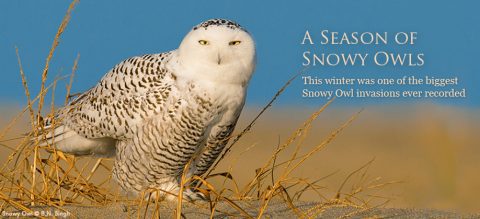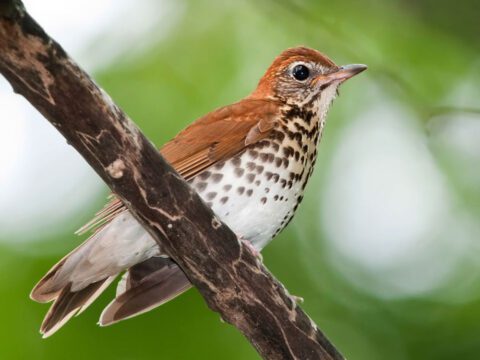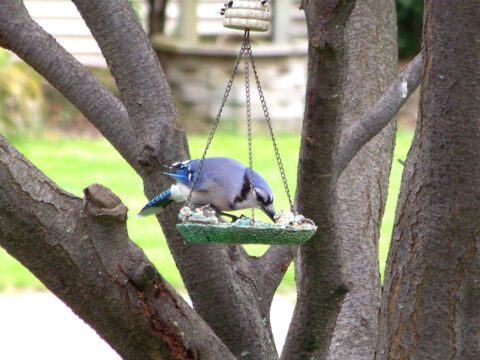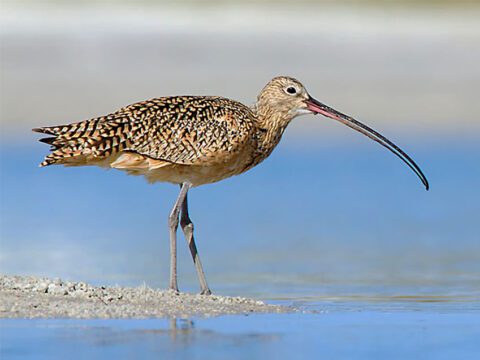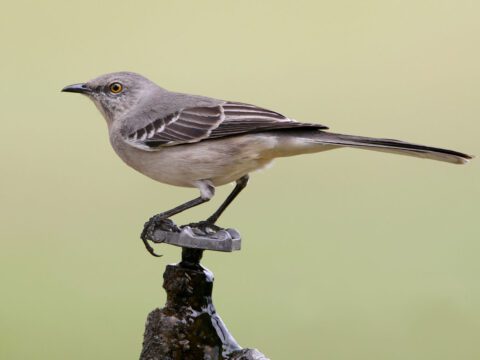This Bird Cam Puts an Albatross Outside Your Window
By Hugh Powell
From the Spring 2014 issue of Living Bird magazine.
April 15, 2014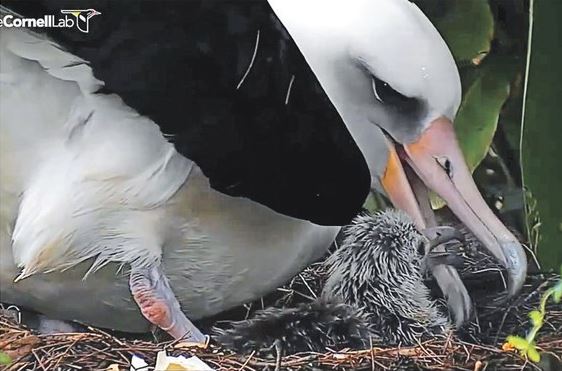
Note: The Laysan Albatross cam ran from 2014 to 2018.
Most people never get to see an albatross. Those who do typically will catch a glimpse from a ship’s rail of a saber-winged giant with a zen-like mastery of the wind. But in one place in the world, a scant 11-mile strip of coastline on Kauai, Hawaii, Laysan Albatrosses are something else entirely. They’re yard birds.
In November they start to come in from months or years on the open ocean. They fold their slender wings, unfurl their enormous pink feet, and touch down. Longtime mates clack their bills at each other, dance a courtship dance, and then scrape out a nest under a hibiscus bush or next to a driveway. The female lays a single egg about the size of a coffee mug, and then the pair begins taking turns incubating.
At one site near the town of Kilauea, a female named Kaluahine sat on a nest of dry ironwood needles she’d scraped together under an ornamental palm. It was late January. Her bill was a warm peach-orange at the base, bluish gray at the business end. Dark brows and delicate gray shading on her face gave her a severe look. She and her mate, Kaluakane, had been taking turns incubating for the last 57 days. The egg was due to hatch in the next week.
For the Cornell Lab of Ornithology’s Bird Cams team, it was an opportunity to bring some familiarity to one of the most distant of birds. The great majority of Laysan Albatrosses nest on desolate atolls in the Pacific, where a live nest cam is simply out of the question. But Kauai has a few hundred nests, plus electrical power and high-speed Internet.
The new camera is the latest addition to the Bird Cams project, which began in 2012 with a Red-tailed Hawk nest on the Cornell University campus and a Great Blue Heron nest outside the Cornell Lab’s offices. Those cameras drew in more than four million unique viewers in the first year. Subsequent cams featured Ospreys, a Pacific Loon, American Kestrels, and bluebirds, plus two feeder cams that stay live through the winter.
“All we’ve done is open up a window, almost like a real window in your house, and outside it there’s an albatross,” said Bird Cams project leader Charles Eldermire. “We don’t control what the bird does, we just let it be itself.”
“I’m mesmerized by this cam, too, and I’ve seen millions of albatross chicks by now,” said Hob Osterlund, a retired nurse who leads the all-volunteer Kauai Albatross Network, which was instrumental in locating a suitable nest for streaming. With the camera’s close-up view, she said, “you can see the beauty of these animals, their curiosity, and the depth of their social culture.”
“It’s kind of a back door into conservation,” Eldermire said. Once people are interested, he said, they’re more likely to decide, “it’s worth figuring out a way to conserve this treasure.”
Albatrosses need our help. They’re one of the most threatened groups of birds in the world. Even the Laysan Albatross, now with about 1.2 million breeding individuals, has already dodged extinction once in the last century. They still face grave threats—as collateral damage in commercial fishing, from consuming plastic trash in the ocean, and, most seriously, from loss of nesting habitat due to sea-level rise associated with climate change. On Kauai, their biggest threat is from introduced predators—especially unleashed dogs, which can kill adult albatrosses with ease.
Kauai has the potential to be a bright spot in the albatross’s future. The island’s steep bluffs can keep nests safe from sealevel rise, and the population—though still small—has grown from zero to several hundred in the last three decades.
“They absolutely amaze me because of how they can leave here and be gone for months and months and then return to this place,” said Sabra Kauka. Kauka is the Hawaiian kumu, or teacher, who named the birds. She drew their names from the place that these albatrosses keep returning to. “Wai meaning water, and kalua meaning two streams,” Kauka said, “and also two paths, one here on earth and one in the sky.”
Kauka is a tall, round-shouldered woman with long dark hair. She wore two leis of lustrous black kukui shells, and she kicked off her flip-flops to give the nest site a traditional Hawaiian blessing with spring water and fresh salt. She sang a Hawaiian chant in a rich alto, as a strong breeze shook the palm trees above her.
The parents, Kaluahine and Kaluakane, are each at least nine years old—just getting to the age when albatrosses start to breed successfully. Last year they nested on this same property, though their egg did not hatch. This year, their egg began to pip, or crack open, on the day before the Bird Cams team left Kauai.
Kaluahine and Kaluakane may have a long career as parents ahead of them. Laysan Albatrosses live very long lives— the oldest one known nests on Midway. Her name is Wisdom; she’s 63 and tending a chick again this year.
Kauka named the chick Kaloakulua after the phase of the moon during hatching. Between now and fledging, the parents may fly as far as Alaska or Japan to gather food (mainly squid) to feed the chick, which needs to put on at least five pounds and grow into its nearly sevenfoot wingspan. If all goes well, Kaloakulua will fledge in July—and likely will not touch land again for at least three years.
Last year a nearby property owner named Rick Ferguson got to see a chick fledge from the site. The bird had been restless, testing its wings and eventually clambering onto a low rock wall. “You could feel what the bird was thinking,” Ferguson recalled. “The bird’s looking out across the ocean, he has some trepidation. But then he kind of builds up his nerve and just makes that leap of faith. It was just a goosebump kind of moment.”

All About Birds
is a free resource
Available for everyone,
funded by donors like you
American Kestrel by Blair Dudeck / Macaulay Library
